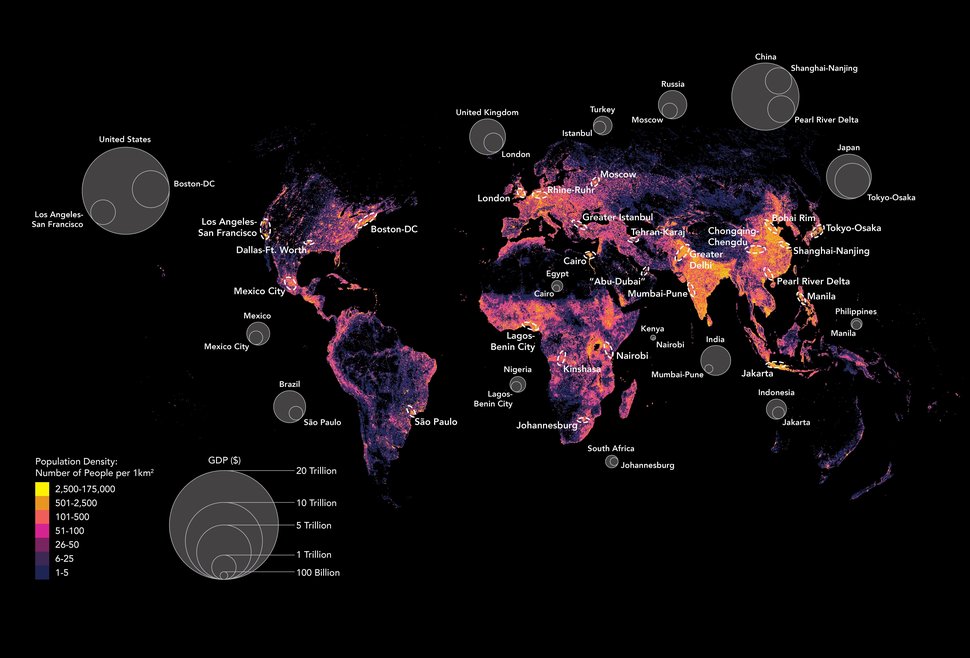One Map Shows What the World's Biggest Cities Will Look Like in 2050

By:
The world as we know it may not be recognizable come 2050.
An increasing number of people are moving to big cities, a trend that will ultimately lead to "megacities," CNN Global contributor Parag Khanna told The Huffington Post.
In the next 10 years, 40 such megacities will emerge, Khanna wrote in his 2015 book, "Connectography." In the United States, one megacity could comprise Washington, Boston, and New York. In Asia, there potentially could be a Tokyo-Osaka, and the Middle East could see Abu-Dubai: a global hub encompassing Abu Dhabi and Dubai in the United Arab Emirates.
 "Connectography"/The Huffington Post - huffingtonpost.com
"Connectography"/The Huffington Post - huffingtonpost.com
The megacities of the future won't be what we consider megacities today: cities with more than 10 million residents, which includes New York, Delhi, and São Paulo, among dozens of others. Rather than individual metropolises, they will be "clusters linked by advanced infrastructure systems" and "major drivers of economic growth," Khanna told HuffPost.
Take Siberia, Russia. Most of us probably imagine it as an uninhabitable region blanketed by snow, where no one would actually want to live. But this once-dreaded locale has transformed in the last few years because of climate change and now hosts a blooming agribusiness, Khanna, said in a 2009 TED Talk. People aren't packing their bags and moving to Siberia in droves just yet, so who's all that grain for?
Across the Amo River in China are the Heilongjiang and Harbin provinces, home to more than 100 million people, which exceeds the entire population of Russia, according to Khanna. He explained:
"Every single year, for at least a decade or more, [60,000] of them have been voting with their feet, crossing, moving north, and inhabiting this desolate terrain. They set up their own bazaars and medical clinics. They've taken over the timber industry and been shipping the lumber east, back into China."
This is how the megacities of the future will form.
Countries will not conquer one another; they'll "lease" space. "That's what I call globalization, Chinese style," Khanna said.
“We should spend time building cities that are viable, connected, and stable,” Khanna told The Huffington Post. “It’s about improving livelihoods and infrastructure and building a path to stability.”
By infrastructure, Khanna in part meant high-speed railways and ample transit routes, something in which Asia and Europe have outpaced the U.S. There exists only one comparable transit system in the United States, and it's in the Northeast. But it travels about 50 mph slower than its counterparts on other continents. This map from "Connectography" shows several regions where megacities may form if high-speed railways are constructed.
.jpeg?auto=format&crop=faces&fit=crop&q=60&w=736&ixlib=js-1.1.0) "Connectography"/The Huffington Post - huffingtonpost.com
"Connectography"/The Huffington Post - huffingtonpost.com
Another essential element of a good infrastructure is wide accessibility to the internet, which facilitates better and easier communication and improved information-gathering capabilities, Khanna said.
“The better the bandwidth, the overall phone penetration, the Wi-Fi hotspots, the better the city will be,” Khanna told HuffPost.
Currently, 54 percent of the world's population resides in urban centers. By 2050, this number will rise to 66 percent, according to the United Nations.
A lot will have to change for Khanna's vision of the world to become a reality, namely how people view political geography. About 90 percent of the global population will never relocate from the area in which they were born, and for them, "nations, countries, boundaries, borders still matter a great deal, and often violently," Khanna said.
Here's how Khanna discussed the issue in his TED talk:
"Border conflicts justify so much of the world's military-industrial complex. Border conflicts can derail so much of the progress that we hope to achieve here. So I think we need a deeper understanding of how people, money, power, religion, culture, technology interact to change the map of the world. And we can try to anticipate those changes and shape them in a more constructive direction."
